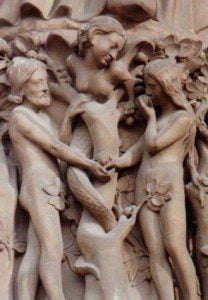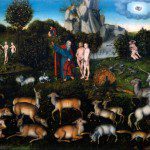 In the last post on the new book in the Zondervan Counterpoints series: Four Views on the Historical Adam we looked at John Walton’s view of Adam as Both Archetypal and Historical (the original post is found at the link). In the post today I will summarize the responses offered by Denis Lamoureux, Jack Collins, and William Barrick (following the order used in the book) and offer some of my own comments as well.
In the last post on the new book in the Zondervan Counterpoints series: Four Views on the Historical Adam we looked at John Walton’s view of Adam as Both Archetypal and Historical (the original post is found at the link). In the post today I will summarize the responses offered by Denis Lamoureux, Jack Collins, and William Barrick (following the order used in the book) and offer some of my own comments as well.
Denis Lamoureux notes his great respect for John Walton, but also disagrees with the way he structures a significant part of his argument. He does not find Walton’s argument that Genesis refers to function rather than material creation compelling. Both Walton and Lamoureux see ancient science, especially ancient cosmology in the text, and both agree that this is “incidental” although Walton phrases it differently. The real difference seems to be in the understanding of the intent of the ancient authors.
As I understand it:
Walton’s hypothesis is that the intent of the ancient author was to describe the shaping of function from chaos and that the material description, using the ancient understanding of science, is incidental to this intent. The functional message carries theological importance and is the intended message of the author (divinely inspired by God).
Lamoureux believes that the intent of the ancient author or editor was to describe creation including material origins. The author was inspired by God, but God accommodated his message to the understanding of the ancient Near Eastern audience and used their understanding of science and and of origins to carry the inspired theological message.
The different view that Walton and Lamoureux take toward accommodation leads to distinct differences in the interpretation of Genesis 1-3 and in the approach each takes to the question of Adam. Lamoureux suggests that Walton stretches the interpretation because he views the text as free from error in the intended message of the author. Examples include Walton’s argument that dust refers to the mortality of Adam rather than the material origins of Adam, the assignment of a priestly role or function for Adam, and his suggestion that the creation of Eve refers to a vision given to Adam while in a deep sleep.
Lamoureux takes the position that the description of Adam and Eve largely reflects an ancient understanding of material origins and is incidental to the theological message. There is no reason to view Adam and Eve as historical persons or as archetypes. (Both Walton and Lamoureux seem to agree quite closely on the intended theological message of the text.)
C. John (Jack) Collins also respects Walton. But he also thinks that Genesis describes material origins, and is not sure why Walton emphasizes a distinction between functional and material origins. Collins most significant disagreement however, is with the idea that Adam need not be the first human or the only human, but “a real person given a real test, as representative and archetype of all humankind.” (p. 130) In particular Collins disagrees with the idea that humans before or contemporary with Adam could have been engaging in activities which we would call sinful. In his view moral innocence – inherent in the words good and upright (Genesis 1, Eccl. 7:29, 1 Tim 4:4) – preceded the first sin, and this seems contrary to Walton’s proposal.
Collins also finds a representative view troublesome because it “raises serious questions about the justice of God in accounting the sin of this couple to their contemporaries, without having some kind of natural relationship between them.” (p. 130)
He concludes: “In sum then, I do not see how Walton’s approach accounts for the unified origin of humankind, or for the foreignness of sin in God’s plan.” (p. 131)
Collins goes on to bring up the nature of humans as the image of God. The image of God is not, in his view, merely a role and function, but a material difference between humans and other creatures.
[W]e must see the image as something that clearly distinguishes humans from every other “living creature.” Whatever distinctive functions we humans exercise, and especially “dominion” (Gen. 1:26; cf. Ps 8), requires that we have the capacities that everyone recognizes as setting us apart from other animals. The “special creation” whatever material it operates on, must impose new features on both body and soul of the new creation; the body-soul unity is needed as the vehicle of this image. (p. 131)
This criticism of Walton’s emphasis on function and role is interesting – and at odds with the argument of J. Richard Middleton and many other Old Testament scholars as well. We have capacities which set us apart from other animals, but these capacities are distinctive in quantity and aggregate, not as unique features unknown in the rest of the animal kingdom. The features are not, many agree, what define us as the image of God.
William Barrick appreciates some of the insights that Walton brings regarding the importance of function and role. He does not see that this is separate from the importance of Adam as the biological head of the human race. He also emphasizes what he sees as the importance of the seminal headship of Adam. He holds that we are endowed with a sin nature at conception transmitted from our parents and we go astray in the womb. “Only the unique conception and birth of Jesus kept him free from receiving the same sin nature.” Thus the special creation of Adam from the dust, without sin and the virginal conception of Jesus are ideas tied together in Barrick’s view.
According to Barrick, Walton’s archetypal view of Adam and his emphasis on function rather than material origins does not do justice to a number of significant theological concepts. It does not do justice to the character of God (“wholly truthful, all-powerful, and all-wise“). It does not do justice to the nature of mankind (fallen through Adam), and thus to the necessity of Christ’s sacrificial death to restore a “fallen mankind and a sin-corrupted and Creator-cursed universe.” Functionality is part of the meaning of the text but … “The physical creation reflects the moral character of God, and his goodness cannot be limited to mere function.” (p. 138)
John Walton responds to a number of the issues raised by Lamoureux, Collins and Barrick. Here I will concentrate only on the theological issues raised by Collins and Barrick. These really center on the same issues surrounding the entry of sin into the world and the propagation of this sin to all mankind. Although Collins sees this as, perhaps, a cultural phenomenon rather than a biological one (he makes analogy to the passing down of citizenship), he does think that it requires a connection between Adam and Eve and all subsequent humanity. Barrick finds the direct biological relationship of importance because sin is passed down in the womb in the very nature of the incipient human.
Walton looks at the scriptures raised by Collins and argues that these passages do not require original sinlessness, only original innocence. The unified origin of humankind is addressed in Genesis 1 – in the creation of humans in the image and likeness of God, male and female. We could rip Genesis 2-3 out of the Bible and still have a united humanity (Walton doesn’t put it quite like this, but the point is the same). The spread of sin is another issue – but Walton admits he doesn’t have a complete answer. Of course the inheritance model also has serious issues as Ronald Osborne points out clearly in Death Before the Fall.
Final Comments. Walton’s approach brings much important insight into the meaning and significance of Genesis 2-3. His emphasis on the archetypal importance of Adam and Eve appears well supported. I have long found his insights into the Garden of Eden enlightening and his emphasis on the priestly role of Adam helps to shape this out. I do agree with Lamoureux that he stretches some points in order to preserve a “truthfulness” in the text, but overall I find his approach more helpful than Lamoureux’s. This is not because I agree with everything Walton says (especially his discussion of the origin of Eve) but because he wrestles with the meaning of the text in the ancient context whereas Denis seems to simply brush it aside as ancient science.
Collins (and I assume Barrick) sees the new heaven and the new earth as a restoration of Eden. Walton has what I consider a view more consistent with the whole sweep of scripture. The move from Eden to new heaven and new earth is a story of sacred space reaching its intended culmination. We are not returning to Eden but moving forward to God’s intended climax. The view of Adam and the spread of sin is a problem that is more significant if we view Eden as God’s intended climax rather than His starting point. We don’t live in a plan gone wrong requiring an emergency patch (Christ) – although we do live in a world tainted by the inability of humans, from the beginning, to maintain God’s sacred space. A view of Adam as archetypal is more (in my opinion) consistent with the whole sweep of scripture than a view of Adam as the origin of sin (as Bouteneff put it in Beginnings – Adam is the original sinner, not the origin of sin).
What do you think?
Does Walton’s emphasis on function and the archetypal role of Adam do justice to the sweep of scripture?
Where might it fail and why?
If you wish to contact me directly you may do so at rjs4mail [at] att.net.
If interested you can subscribe to a full text feed of my posts at Musings on Science and Theology.











